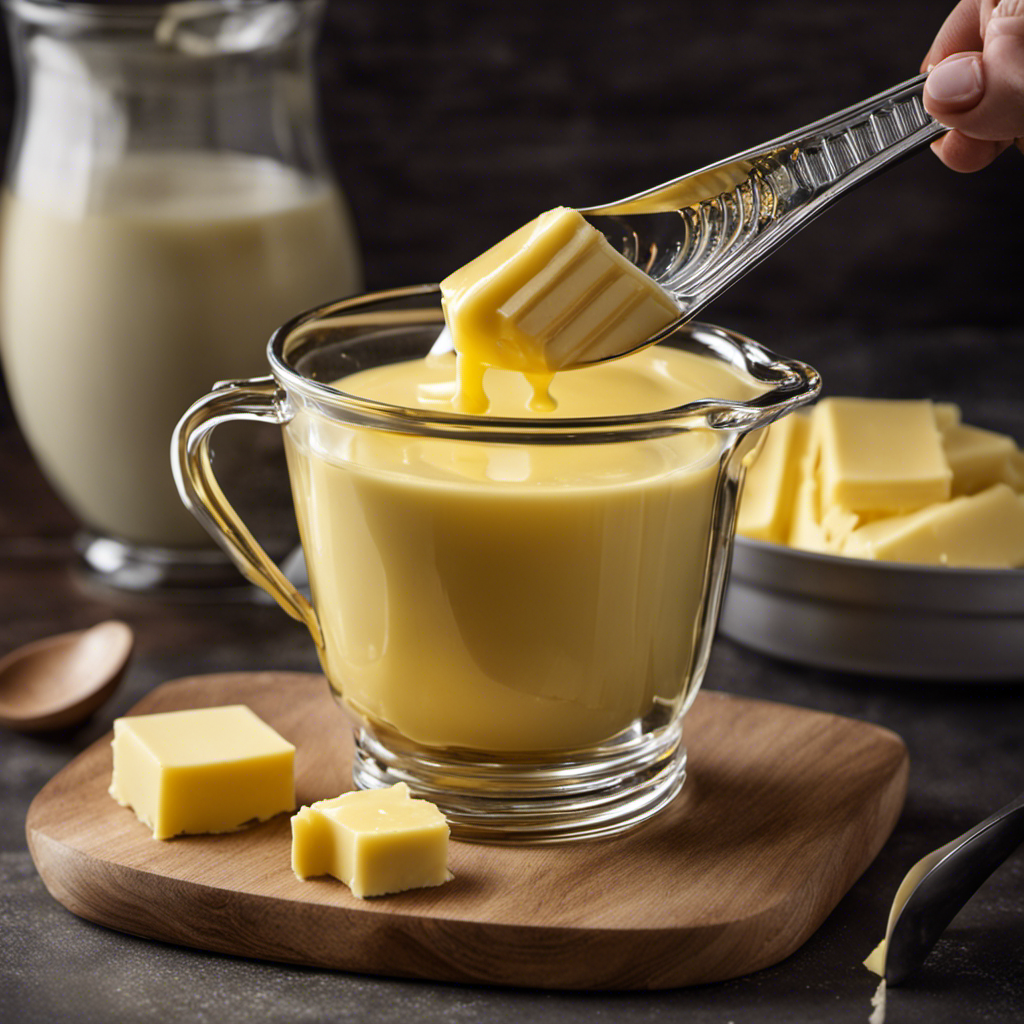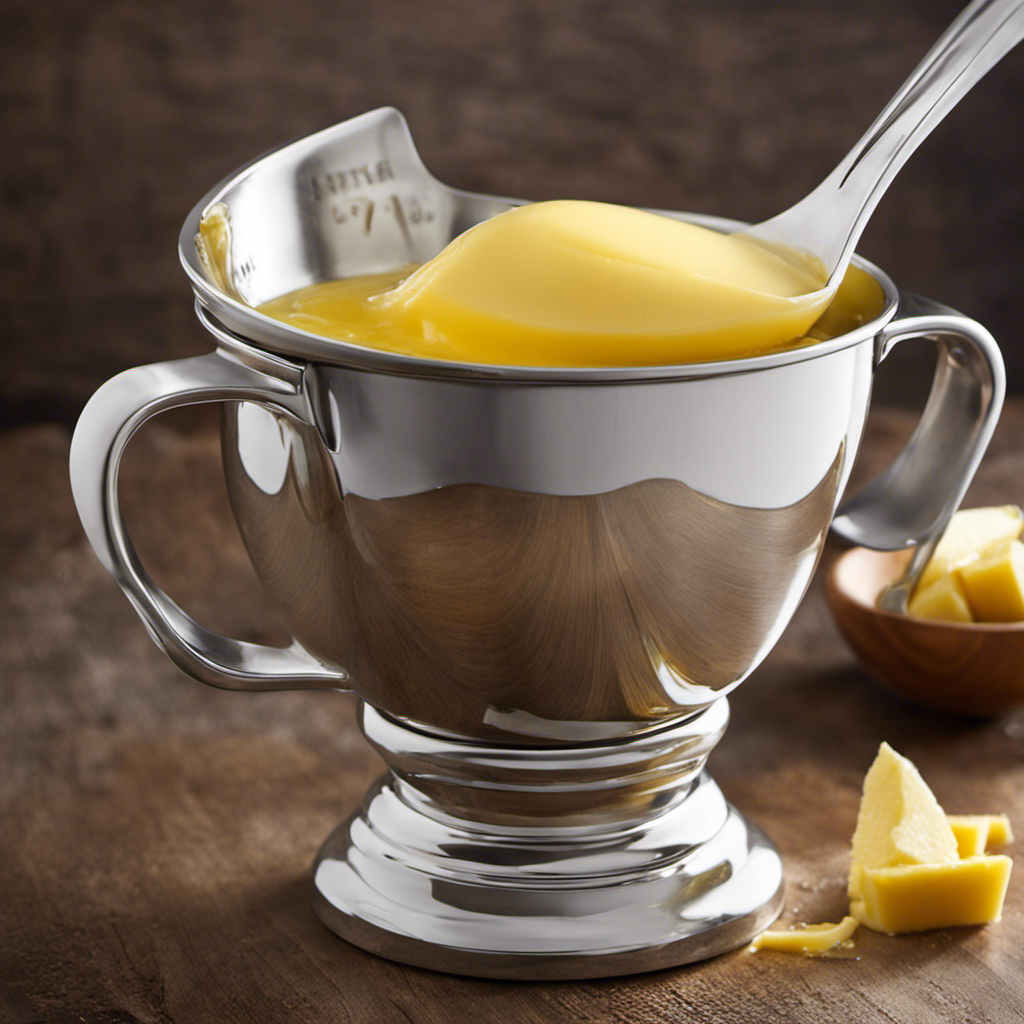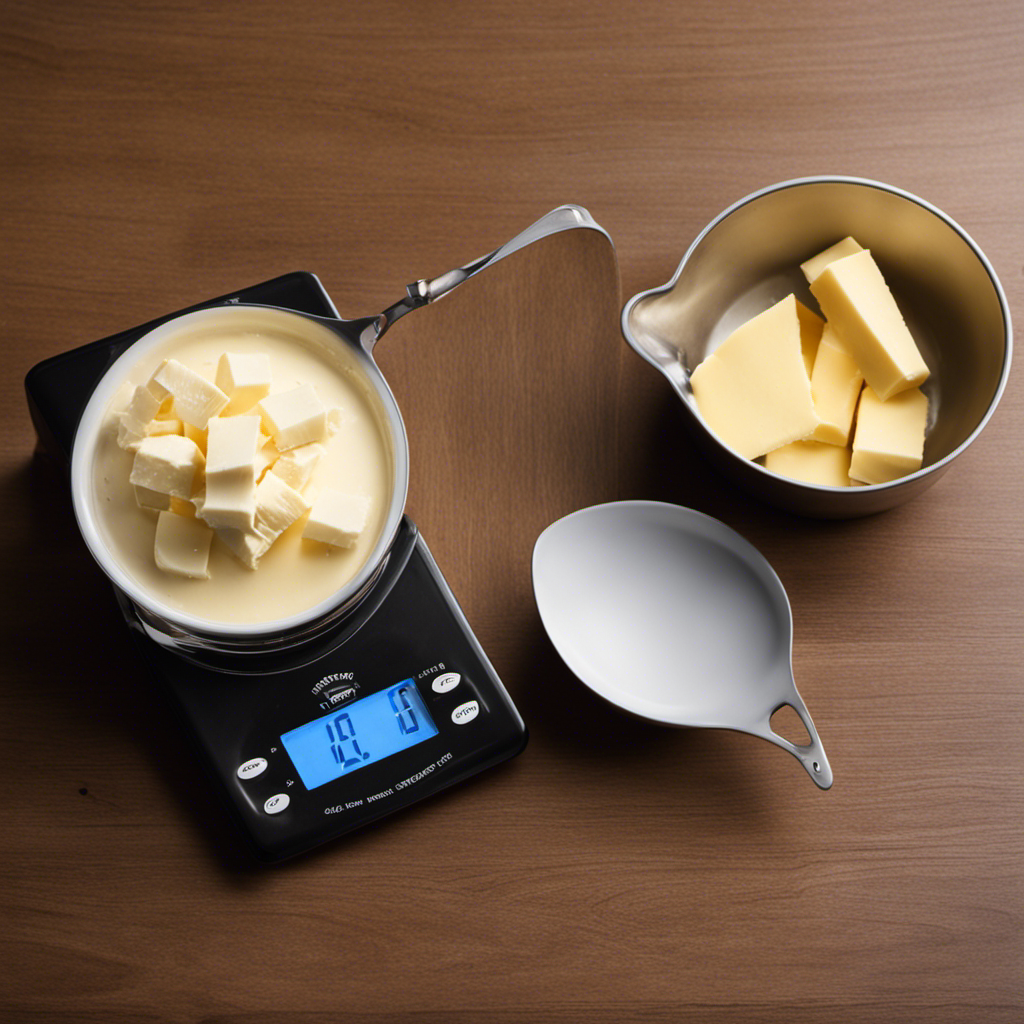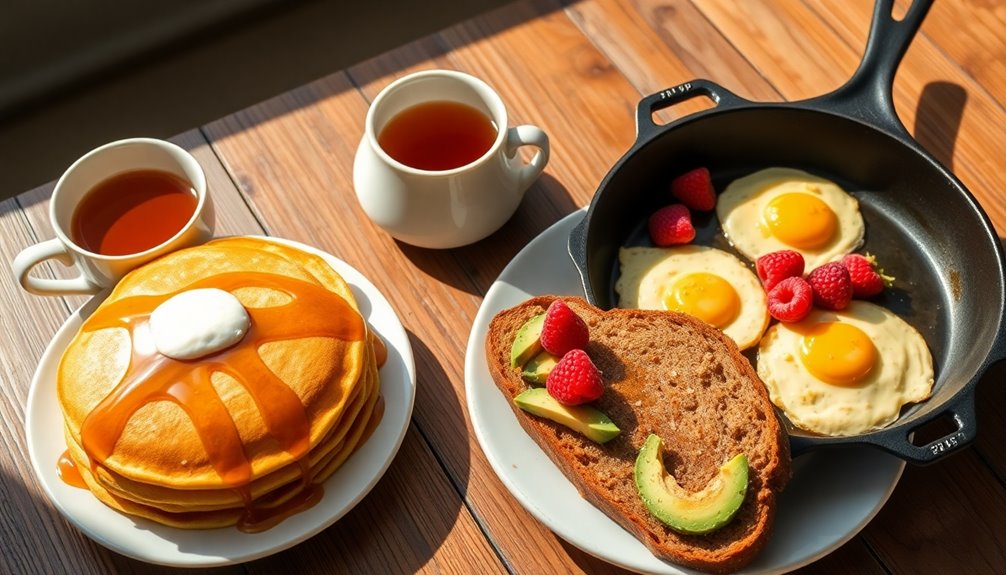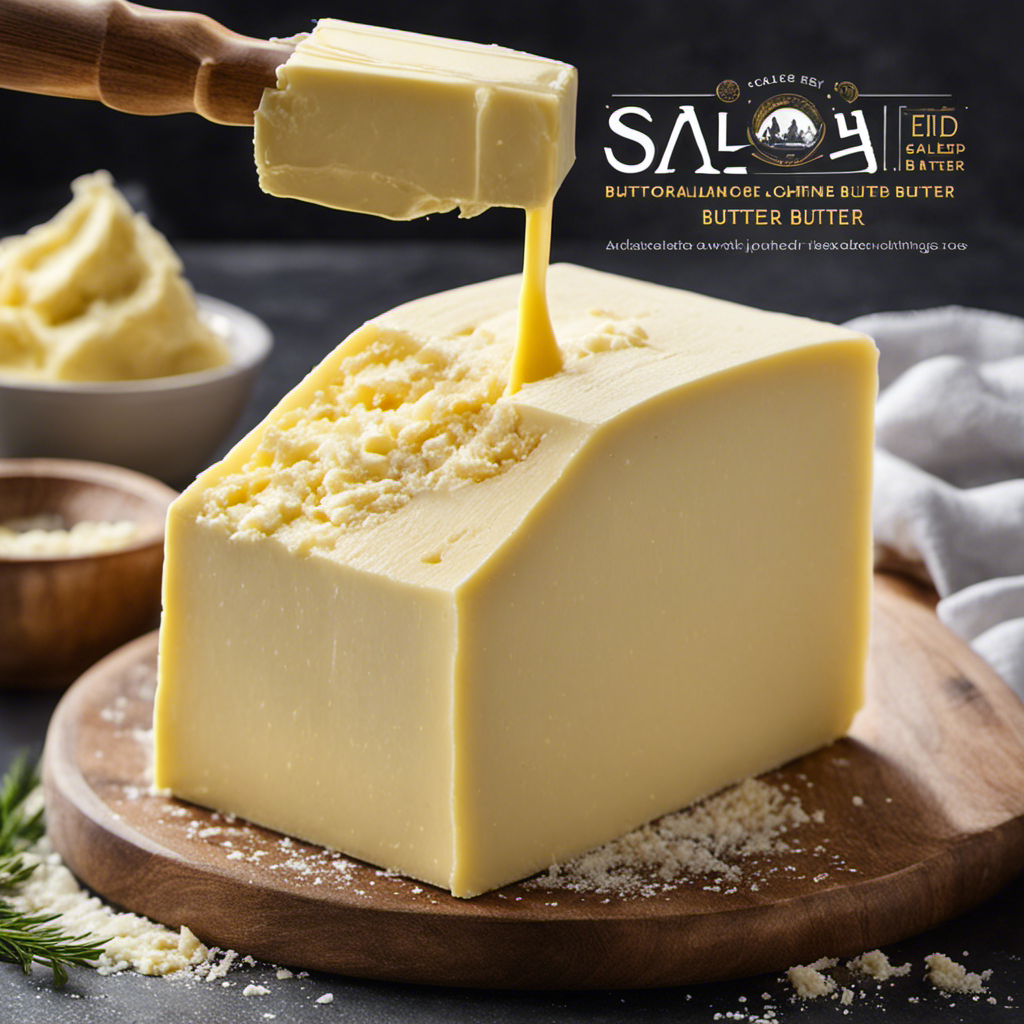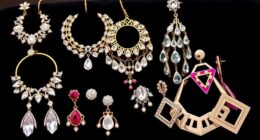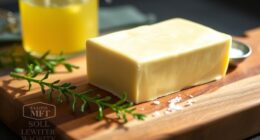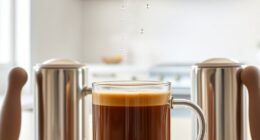I have often pondered how many tablespoons of butter are in 2/3 cup. It is a frequently used measurement in recipes, but the conversion can be a little challenging.
Well, here’s an interesting statistic for you: did you know that there are 10 and 2/3 tablespoons of butter in 2/3 cup? That’s right!
In this article, I’ll break down the measurement process, provide a conversion chart, and give you some tips for accurate butter measurement. So, let’s dive in and solve this buttery mystery together!
Key Takeaways
- Accurate butter measurement is crucial for balanced flavors and textures in dishes.
- Converting 2/3 cup to tablespoons results in approximately 10.67 tablespoons of butter.
- Understanding the conversion process simplifies measuring butter accurately.
- Using a kitchen scale or measuring in tablespoons are common methods for precise butter measurement.
Understanding the Measurement
To understand the measurement, you’ll need to know how many tablespoons of butter are in 2/3 cup.
Measuring ingredients accurately is crucial in cooking and baking. Precise measurements ensure that your recipes turn out just right and that the flavors and textures are balanced.
When it comes to butter, it’s important to know the exact amount needed for a recipe. In 2/3 cup of butter, there are 10 and 2/3 tablespoons. This precise measurement allows you to follow recipes accurately and achieve consistent results.
Whether you’re making a buttercream frosting or a flaky pie crust, knowing how many tablespoons of butter are in 2/3 cup will ensure that your dish turns out delicious and perfectly balanced.
Converting Cups to Tablespoons
Converting 2/3 cup to tablespoons can be done easily. Understanding the conversion process between different units of measurement is essential for accurate recipe preparation. To convert cups to tablespoons, it’s important to know that 1 cup is equal to 16 tablespoons. So, to convert 2/3 cup to tablespoons, we can multiply 2/3 by 16.
First, we need to convert the fraction to a decimal. To do this, we divide 2 by 3, which gives us 0.6667. Then, we multiply this decimal by 16. The result is approximately 10.67. Therefore, 2/3 cup is equal to approximately 10.67 tablespoons.
Converting measurements can be confusing, but with a clear understanding of the conversion process and the different units of measurement, it becomes simple and straightforward.
The Ratio of Butter to Cups
When it comes to baking, getting the measurements of butter right is crucial. In this discussion, we will explore the topic of butter cup conversion and how to measure butter accurately.
Understanding the ratio of butter to cups and learning the proper techniques for measuring butter will help you achieve consistent and delicious results in your baking endeavors.
Butter Cup Conversion
You’ll need to know how many tablespoons of butter are in 2/3 cup. Understanding butter measurements and butter measurement equivalents is essential for any avid baker or cook. To help you convert between cups and tablespoons, here is a handy table:
| Cups | Tablespoons |
|---|---|
| 1/4 | 4 |
| 1/3 | 5 1/3 |
| 1/2 | 8 |
| 2/3 | 10 2/3 |
| 3/4 | 12 |
In this table, you can see that 2/3 cup of butter is equivalent to 10 2/3 tablespoons. This information can be incredibly useful when following recipes that require precise measurements. Whether you’re making cookies, cakes, or savory dishes, understanding butter measurements will ensure accurate results every time.
Measuring Butter Accurately
To measure butter accurately, start by using a kitchen scale. Measuring butter by weight ensures precision in your recipes.
First, place a butter dish on the scale and reset it to zero. Then, add the desired amount of butter, making sure to remove any packaging. The scale will display the weight in grams or ounces, depending on your preference.
This method is especially useful when a recipe calls for a specific weight of butter, such as 4 ounces or 100 grams. By using a kitchen scale, you can be confident that you are adding the exact amount of butter needed for your recipe.
Now, let’s move on to measuring butter in tablespoons, which is another common method of measurement in the kitchen.
How to Measure Butter in Tablespoons
If you’re wondering how many tablespoons of butter are in 2/3 cup, the conversion is approximately 10 and 2/3 tablespoons.
Measuring butter accurately is important when following a recipe. While some recipes specify butter in grams, many still use customary measurements like cups and tablespoons.
To convert grams to tablespoons, you need to know the density of the butter you are using. Different types of butter have different densities, so it’s crucial to check the specific conversion chart for accurate measurements.
This ensures that you add the right amount of butter to your recipe, resulting in the desired outcome.
Now that we know how to measure butter in tablespoons, let’s move on to calculating 2/3 cup in tablespoons.
Calculating 2/3 Cup in Tablespoons
Now that we know how to measure butter in tablespoons, let’s move on to calculating 2/3 cup in tablespoons.
To convert butter measurements, it’s important to understand the ratio. There are 16 tablespoons in 1 cup of butter. So, to calculate 2/3 cup in tablespoons, we can multiply 2/3 by 16.
To simplify the calculation, we can convert 2/3 into a decimal by dividing 2 by 3, which equals 0.67. Then, we multiply 0.67 by 16 to get the final answer.
0.67 multiplied by 16 equals approximately 10.67 tablespoons. Therefore, 2/3 cup of butter is roughly equivalent to 10.67 tablespoons.
Understanding these calculations will help us accurately convert butter measurements in the future. Now, let’s move on to the next section to learn some tips for accurately measuring butter.
Tips for Accurate Measurement
When it comes to accurate measurement, there are common mistakes that can easily be made. It is crucial to be aware of these mistakes in order to ensure precise results.
One key point to remember is the importance of leveling off the ingredients, as even a slight variation can significantly affect the final outcome.
Common Measurement Mistakes
One common mistake is not accurately measuring the ingredients when cooking. It’s easy to overlook the importance of precise measurements, but it can greatly affect the outcome of your dish. Here are some common kitchen mistakes to avoid when measuring ingredients:
- Eyeballing measurements instead of using a measuring cup or spoon.
- Not leveling off dry ingredients, which can lead to too much or too little in your recipe.
- Using liquid measuring cups for dry ingredients, resulting in inaccurate measurements.
- Not properly packing ingredients like brown sugar, which can affect the texture and sweetness of your baked goods.
- Neglecting to calibrate your scale, leading to inaccurate measurements by weight.
Accurate measurements ensure that your dishes turn out as intended, so it’s essential to take the time to measure ingredients properly.
Now, let’s delve into the importance of leveling off for precise measurements.
Importance of Leveling off
Accurate measurements ensure that your dishes turn out as intended, so it’s crucial to level off dry ingredients for precise measurements.
When it comes to cooking and baking, precision is key. Even the slightest deviation in measurement can have a significant impact on the final outcome of your dish. Improper measurement can result in a variety of issues, such as a cake that doesn’t rise properly, cookies that spread too thin, or a sauce that is too thick or watery.
It’s important to level off dry ingredients, such as flour or sugar, to ensure that you are using the exact amount called for in the recipe. This simple step can make a big difference in the texture, flavor, and overall success of your culinary creations.
Butter Measurement Conversion Chart
To convert 2/3 cup of butter to tablespoons, you’ll need to consult a butter measurement conversion chart. This chart will provide you with the precise measurement you need to substitute butter in your recipes.
Here are some additional points to consider when looking for butter substitute options and baking with margarine:
- Coconut oil: A popular alternative to butter, it adds a subtle flavor to baked goods.
- Olive oil: A heart-healthy option that works well in savory dishes.
- Applesauce: Perfect for adding moisture to cakes and muffins while reducing fat content.
- Greek yogurt: A great choice for adding creaminess and tang to recipes.
- Avocado: Its rich texture makes it a suitable replacement in recipes that call for butter.
When baking with margarine, keep in mind that it contains more water than butter, which can affect the texture and moisture of your final product. Adjustments may be necessary to achieve the desired results.
Frequently Asked Questions
Can I Use a Different Type of Butter, Such as Margarine or Vegan Butter, in Place of Regular Butter When Measuring in Tablespoons?
Yes, you can use different types of butter alternatives, like margarine or vegan butter, as a substitute for regular butter when measuring in tablespoons. However, keep in mind that using different types of butter may have an impact on the texture and taste of your recipes.
How Do I Measure Butter in Tablespoons if I Don’t Have a Tablespoon Measuring Tool?
If I don’t have a tablespoon measuring tool, I can use common kitchen items as alternatives. For example, one tablespoon is equivalent to about half an ounce or 14 grams of butter.
Are There Any Tips for Accurately Measuring Butter in Tablespoons, Especially if It Comes in a Block or Stick Form?
When measuring butter in tablespoons, accuracy is key. Different forms of butter, like blocks or sticks, can make it tricky. To measure accurately, soften the butter first and use a tablespoon measuring tool.
Can I Use a Butter Measurement Conversion Chart to Convert Other Ingredients, Such as Oil or Shortening, Into Tablespoons?
I can use a butter measurement conversion chart to convert other ingredients like oil or shortening into tablespoons. However, it’s important to note the difference between measuring butter and shortening in tablespoons for baking.
Are There Any Specific Considerations or Adjustments to Keep in Mind When Measuring Butter in Tablespoons for Baking or Cooking Purposes?
When measuring butter in tablespoons for baking or cooking, there are a few considerations. The temperature of the butter can affect the accuracy of the measurement, so make sure it’s at the recommended temperature.
Conclusion
In conclusion, understanding the measurement of butter in tablespoons is essential for accurate cooking and baking.
Converting 2/3 cup of butter to tablespoons can be tricky, but with the right ratio and measurement techniques, it can be done easily.
While some may argue that using a conversion chart is time-consuming, taking the time to measure butter accurately will result in delicious and perfectly balanced recipes.
So, don’t underestimate the power of precise measurements and let your culinary creations shine!
